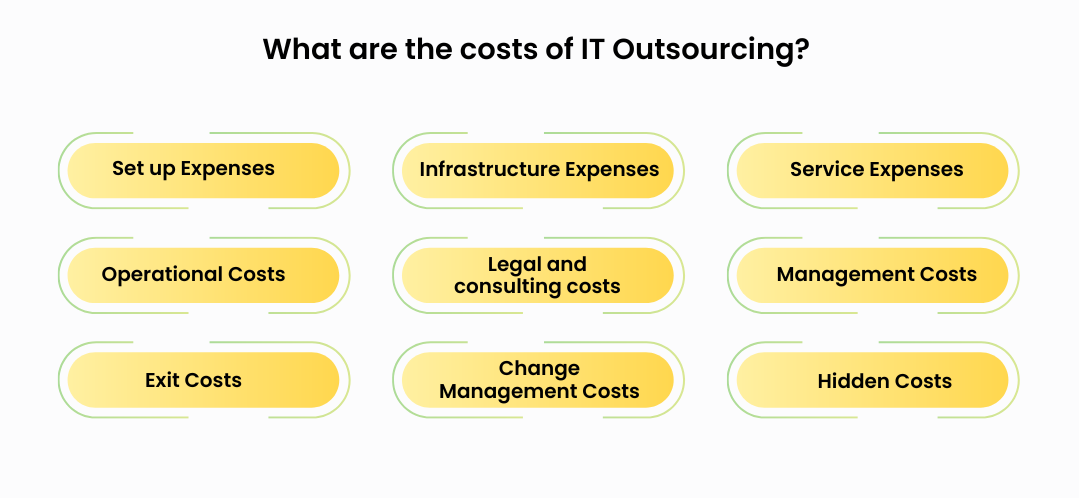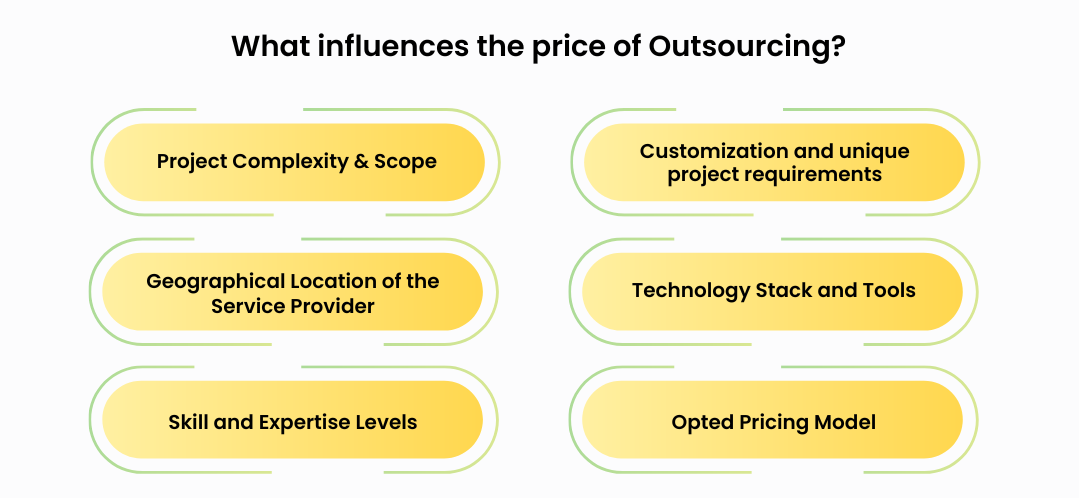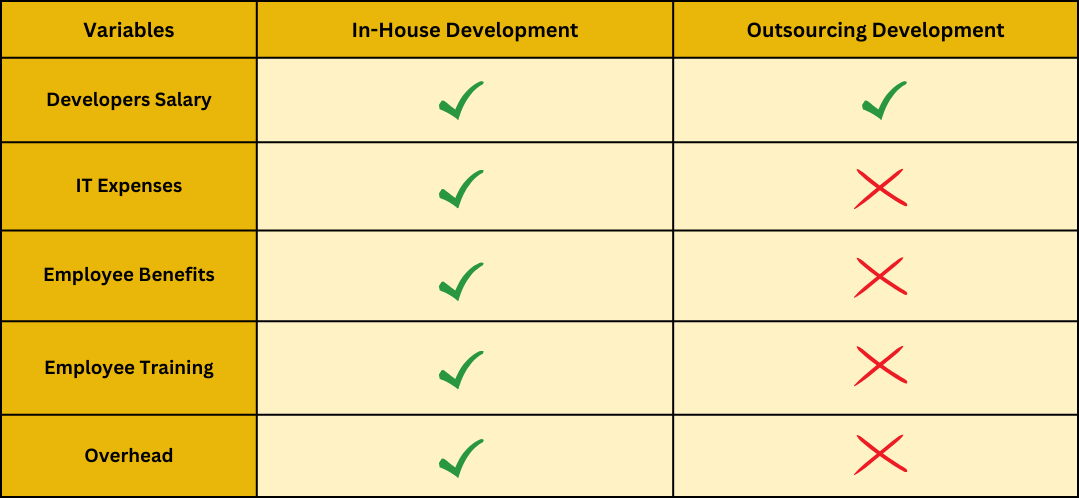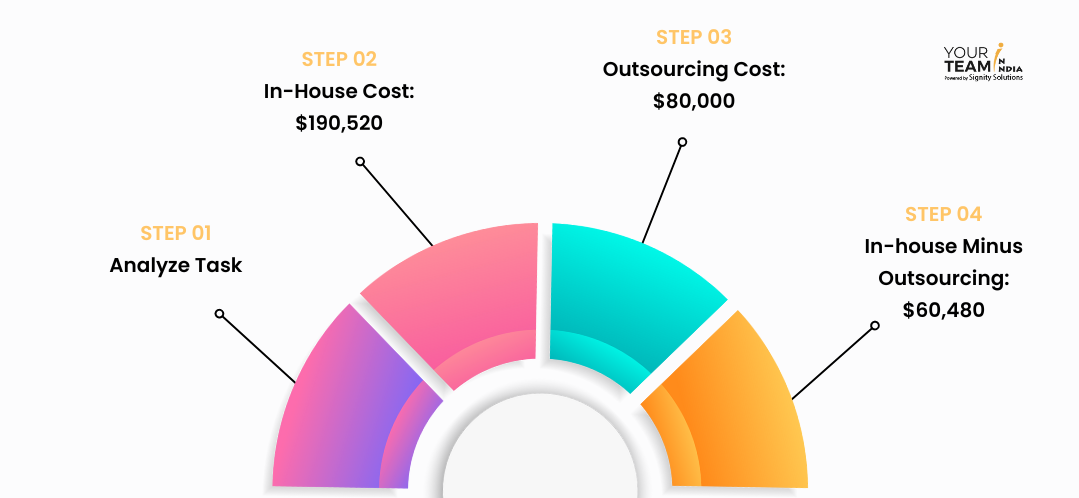Quick Summary: Analyzing the IT Outsourcing cost accurately is essential for making well-informed budget-related decisions. This blog aims to offer valuable insights into the evaluation of IT outsourcing expenses and how to calculate the expenditure associated with procuring outsourced services.
Introduction
Every business strives to save money whenever feasible. For some companies, choosing IT services from an outsourcing service provider can substantially reduce time for large products and costs, while others benefit from the strategic technological expertise that may not be available within the in-house teams.
In certain scenarios, businesses look for external assistance as their in-house IT teams require additional support.
Whatever the reason, seeking external help benefits businesses in various ways, and that is why it is crucial to analyze the IT Outsourcing costs beforehand.
Key Takeaways
- One of the most appealing gains of IT Outsourcing is the capacity to optimize your budget by paying less for significantly higher-quality software.
- Lacking comprehensive information about the current operational costs might hinder you from accurately determining the outsourcing expenses. Before considering outsourcing as a cost-saving measure, it's crucial to calculate your company's operational genuine expenditures.
- No one size fits all. The cost of a comprehensive software product development project varies based on your software requirements, size, complexity, necessary team, and the timeline for completion.
- To accurately estimate the extent of cost reduction, it's imperative to have a thorough understanding of the IT outsourcing costs.
This blog post provides crucial information on evaluating IT outsourcing services costs and other related insights. Keep reading to learn more.
Is IT Outsourcing really cost-effective?
Before moving to the IT outsourcing costs and other crucial factors, the simplest question to consider is whether IT outsourcing is really cost-effective.
Well, it's probably a yes. Outsourcing IT services can bring significant cost savings when partnered with a reliable service provider.
“IT outsourcing refers to acquiring IT services from external service providers to provide IT-enabled business processes, infrastructure solutions, and web application services for productive business outcomes. “
And it is one of the primary reasons why companies opt to outsource their IT services.
Can't believe the words? Check out the numbers in the graph below, and you’ll get your answer.
And not only this, IT Outsourcing helps by:
- Achieving a significant reduction in development costs, typically ranging from 40% to 70%. This enables businesses to have better control over their expenses and budget effectively.
- Accessing specialized skills essential for technology projects and the flexibility to rapidly adjust workforce size through staff augmentation or managed project outsourcing.
- Discovering cost-effective technology talent to drive continuous digital transformation initiatives.
Recommended Read: The All-In-One Guide to Software Development Outsourcing
What Are The Costs Of IT Outsourcing?

Engaging in IT outsourcing entails both direct and indirect costs. Below are the key expenses typically linked with IT outsourcing:
-
Set up Expenses
These encompass the costs related to establishing the outsourcing agreement, which may cover expenses for infrastructure setup, service transition, and transferring processes or data to the outsourcing provider.
-
Infrastructure Expenses
The IT outsourcing infrastructure expenses encompass hardware, software licenses, cloud services, Backup and disaster recovery solutions, and many more. Understanding and managing infrastructure costs strategically empowers businesses to make informed decisions in IT outsourcing, ultimately enhancing operational efficiency and cost-effectiveness.
-
Service Expenses
These represent the expenses associated with the specific IT service undergoing outsourcing. They encompass software development, application maintenance, system administration, managed IT services, cloud services, and similar offerings. Typically, these constitute the core expenses and may be billed using fixed-cost, per-user, per-device, or per-service models.
-
Operational Costs
Operational costs are the continuous expenses involved in upkeeping the outsourced IT service. This encompasses expenditures for system upgrades, software licensing fees, and technical support.
-
Legal and Consulting Costs
Legal and consulting costs include costs related to negotiating, creating, and examining the outsourcing contract. This category may also encompass continuous legal and consulting fees to ensure the company's adherence to pertinent laws and regulations.
-
Management Costs
Management costs encompass expenses associated with overseeing outsourced services and the outsourcing provider. This includes the salaries of internal staff dedicated to provider communication, the time and resources spent on supervision and governance, and the expenses incurred in coordinating and integrating the provider's services with the overall business operations.
-
Exit Costs
Exit costs refer to expenses associated with concluding the outsourcing relationship. This encompasses the cost of transitioning the service back in-house or to a new provider and any contract termination fees.
-
Change Management Costs
Change management costs pertain to adjustments in the outsourcing agreement, such as scaling services, introducing new elements, or transitioning to a different provider. This category may also encompass training expenses if your team requires instruction on new systems or processes necessitated by the change.
-
Hidden Costs
The hidden costs encompass various additional expenses not accounted for in the above points. This includes the supplementary marketing expenses for the offered product. Apart from this, several other types of often overlooked costs include:
- Maintaining an outdated outsourcing strategy
- Managing and coordinating service providers
- Inappropriate sales and operations strategy
- Warranties and other allowances
- Unforeseen and unplanned risks
- Poor and substandard quality
- Unexpected logistics and premium freight
Essential to note!
Selecting a reliable and experienced service provider is imperative to mitigate these hidden costs.
Factors Impacting the Cost of IT Outsourcing
IT Project Outsourcing is a common business strategy to tap into specialized expertise and trim operational expenses.
Before evaluating the costs of IT outsourcing services and considering potential savings, it is important to understand the various factors that impact them. It is crucial to note that not every IT Outsourcing project incurs the same expenses. Some projects, such as a Minimum Viable Product (MVP), can be completed quickly with a smaller budget, while others may require a significant investment. Therefore, it is essential to understand these factors that influence the costs.
Don't worry; you do not have to search for them separately. Below, we have compiled all the factors affecting the IT outsourcing costs.
Here are the primary cost-influencing factors:

-
Project Complexity and Scope
The intricacy and breadth of an IT project are foundational cost drivers. Projects incorporating intricate solutions, extensive functionalities, or cutting-edge technologies typically demand more resources and time, resulting in elevated expenses.
-
Geographical Location of the Service Provider
The location of the outsourcing partner significantly affects costs. Countries or regions with a higher cost of living generally command higher rates for IT services compared to areas with lower living expenses.
Outsourcing Costs can fluctuate significantly based on the region. For example, app development expenses tend to be higher in regions like the UK and the US but more affordable in countries with lower living costs. The table below illustrates hourly rates across various regions:
|
Geographical Region |
Hourly Rate |
|
United States |
$100-$150 |
|
United Kingdom |
$100-$120 |
|
Western Europe |
$70-$100 |
|
Australia |
$100-$140 |
|
Eastern Europe |
$30-$60 |
|
India |
$20-$60 |
The above table clearly indicates that opting for outsourcing in India is a viable choice. With its lower cost of living and the availability of the required skillset at affordable rates, India emerges as an attractive option.
-
Skill and Expertise Levels
The required expertise and experience are key factors in cost estimation. Highly specialized skills or expertise in niche technologies may lead to higher rates for developers and experts.
-
Customization and Unique Requirements
Projects requiring extensive customization or unique features may necessitate additional time and effort from the development team, resulting in increased costs.
-
Technology Stack and Tools
The selection of technology stack and development tools can impact costs, as certain technologies may require specialized expertise or licenses, leading to higher expenses.
-
Project Timeline and Deadlines
Stringent project schedules may necessitate extra resources and could result in additional charges for expedited delivery, potentially increasing the overall project expenditure.
-
Quality Assurance and Testing
Thorough testing and quality assurance processes ensure a dependable and secure IT solution. Prioritizing comprehensive testing may lead to an increase in the overall project expenditure.
-
Scalability and Flexibility
Projects necessitating the capability to adjust resources based on demand may exhibit distinct cost structures compared to fixed-scope projects.
-
Legal and Compliance Considerations
Adhering to industry regulations, data protection laws, and intellectual property rights may incur extra-legal and compliance expenses.
-
Post-Implementation Support and Maintenance
Including ongoing support and maintenance services in the overall cost estimation is essential once the project is completed.
-
Communication and Collaboration Requirements
Efficient communication and collaboration are crucial for project success. Factors like language barriers, time zone disparities, and the necessity for specialized collaboration tools can influence costs.
-
Service Providers Reputation
Outsourcing vendors with established reputations charge higher rates to reflect their successful project deliveries.
By comprehending these factors and meticulously analyzing project requisites, businesses can achieve more precise cost estimates for their IT outsourcing projects. This consideration empowers them to make well-informed decisions, ultimately contributing to the success of their outsourced IT endeavors.
However, businesses are still skeptical about making a decision on outsourcing or choosing an in-house team. Well, no looking further as we are going to clear your doubt here only.
In-House vs. Outsourcing Cost Analysis
The debate on whether to outsource or maintain in-house teams has been persistent. Yet, arriving at a decision marks a significant milestone. The following analysis will guide you in making a choice.
In-House Fulfillment Cost Analysis: Factors that will Affect the Overall Cost
When you are handling your own fulfillment in-house, you have to pay overhead costs. Furthermore, you have to pay for their training, other employee benefits as well as hardware & software requirements. Here are the main categories:
- Insurance
- Per Head
- Rent
- Software
- Supplies
- Utilities
Outsourcing Fulfillment Cost Analysis: Factors that will affect the overall cost
If you are outsourcing your IT development, you won’t have to pay the overhead costs, which is a big factor in cost determination. Instead, you will pay your IT outsourcing partner a fixed fee, which the Outsourcing cost calculator will determine. Elements that will be included:
- Call Support
- Customer Service
- Cartons
- Order Fulfillment Fees Per Order
- Order Fulfillment Fees Per Item
- Receiving Fees
- Returns Fees
- Storage Fees
- Set Up Fee – One Time
Outsourcing is a tough decision to make. But knowing how much software development would actually cost can drastically change your perspective, weighing the other factors impacting your decision. If you plan to set up an offshore development center, it’s best to evaluate the cost to do so.
So, this differentiation clearly indicates that outsourcing leads to cost reduction in the overall project implementation. To demonstrate it more clearly, check out the table below.

Does the above table influence your decision of making a choice to outsource some of your IT Operations? Well, if still not, do not forget to check out in-house vs. outsourcing to make an informed decision.
Can IT Outsourcing Cost Less Than Hiring An In-House Team?
Outsourcing IT services is a cost-effective solution for businesses that require specialized skills, need to manage short-term projects, want to reduce overheads, and desire flexibility in resource allocation. Although both options have advantages, there are situations where IT outsourcing can provide significant cost benefits compared to hiring an in-house team. Here are some key scenarios where outsourcing proves to be the more economical choice:
- Choosing the correct service provider
- Establishing clear and open communication
- Securing the necessary skills and expertise
- Emphasizing superior quality over cost considerations
- Having greater control and flexibility
- Avoiding hidden expenses
How to Evaluate IT Outsourcing Costs?
Evaluating the outsourcing cost estimation is crucial when deciding on whether to outsource or build an in-house team for your business. Certainly, to get the best hire for you, it is essential to find reliable IT Outsourcing Partners who can facilitate to take the total costs at a substantial number.
To assess the actual cost of IT outsourcing, there are three viable approaches to consider:
- Differential Cost Analysis
- Opportunity Cost
- Incremental Cost
Differential Cost Analysis
Differential cost analysis, in its simplest form, involves subtracting the outsourcing cost from the in-house cost. To understand this better, let us check out the steps below with examples. Here's a step-by-step guide on how to determine the actual cost of outsourcing:
Step 1: Analyze the Task
When considering outsourcing a task or project, examining its scope, intricacies thoroughly, and required expertise is important. The first step is to define the services that will be outsourced clearly. Defining a set of steps and processes for the service can greatly improve cost analysis. For example, in software product development, it is crucial to outline various aspects such as the target platform, user interface and user experience (UI & UX), functionality, backend infrastructure, level of customization, MVP or prototype creation, performance assessment, and more. This detailed delineation facilitates a more comprehensive cost assessment.
Step 2: Calculate Actual In-House Cost
To determine the total cost of carrying out a task in-house, calculate all direct and indirect expenses comprehensively. This should include salaries, benefits, supplies, IT infrastructure, hardware, software, and other necessary costs. Also, calculate the expenses incurred if the task was not outsourced. For example, if you outsource software product development, the in-house development cost would be around $190,520. This figure includes the expenses associated with hiring a developer, such as their salary, benefits, IT supplies, training costs, and other related expenses.
Step 3: Calculate Outsourcing Cost
After determining the cost of developing software products in-house, the next step is to calculate the total expenses involved in outsourcing the same services. This includes all expenses from the bid price to any additional integration required for a smooth transition. For instance, if you outsource software product development, the total cost of the operation will be around $80,000, representing the entire outsourcing expenditure.
Step 4: In-House Cost Minus Outsourcing Cost
We have finally arrived at the last and most straightforward phase of analyzing the difference in cost between outsourcing and in-house operations. Simply subtract the outsourcing cost from the in-house cost to obtain the differential cost. This numerical value represents the potential savings or additional expenses associated with outsourcing. In this particular scenario, the calculation would be $190,520 - $80,000, which equals $60,480.

By adhering to these procedures, you can execute a comprehensive differential cost analysis, enabling you to make an informed decision regarding outsourcing.
Differential Analysis Cost Formula:
Outsourcing Amount Savings = In-house Cost - Outsourcing Cost
The method we've just discussed is the differential cost analysis, which provides us with a quantifiable representation of the savings achieved through outsourcing. Now, let's explore two alternative approaches to calculating outsourcing costs.
Opportunity Cost Analysis
Opportunity cost is the cost or benefit you miss out on when choosing one option over another. In the case of handling operations, the opportunity cost would be the potential expense or benefit you might lose if you decide to do it in-house rather than outsourcing development. It represents the value that you could have gained but gave up by choosing in-house operations over outsourcing.
Opportunity Cost Formula:
Opportunity Cost= Return on the Best Forgone Option - Return on the Selected Option
Incremental Cost Analysis
Companies often underestimate the incremental cost when deciding whether to outsource. The incremental cost, also called marginal cost, refers to the financial impact of creating and selling an additional product unit on a company's balance sheet or income statement. It includes the additional expenses a company faces when considering a change in its operational approach.
Incremental Cost Formula:
Incremental Cost = Total cost of producing two units - Cost of making a single unit
In the case of outsourcing, incremental cost refers to the extra expenses incurred when choosing to outsource operations.
Now that the above section shares how IT Outsourcing costs can be analyzed, sometimes it is essential to calculate the approximate cost for a hire. The below content shares how one can calculate the IT Outsourcing cost.
What to Expect From IT Outsourcing In 2024?
As we near the end of 2023, IT outsourcing is expected to continue to play a crucial role in helping businesses remain competitive. However, there are some predictions for the upcoming year that may impact the cost of accessing outsourced services in different geographical regions. Let's take a closer look at these predictions.
Latin America
Developer rates will slightly increase in 2024 with minor changes caused by fluctuating exchange rates. Expect a 6% to 10% rate increase due to inflation.
A modest increase is anticipated next year, so for 2024, expect the range of rates below (/hr).
|
Experience level |
Rates (/hr) |
|
Junior Developer |
$38 - $52 |
|
Intermediate Developer |
$50 - $64 |
|
Senior Developer |
$65 - $74 |
Eastern Europe
Due to the geopolitical situation, development rates plateaued in 2023 and are expected to increase by only 1%-10% in 2024, according to 60% of surveyed firms.
A modest increase is anticipated next year, so for 2024, expect the range of rates below (/hr).
|
Experience level |
Rates (/hr) |
|
Junior Developer |
$37 - $52 |
|
Intermediate Developer |
$53 - $68 |
|
Senior Developer |
$64 - $78 |
South Asia
Asia is the only region where the lower outsourcing costs have always been in the top searches. However, an increase is anticipated in rates ranging from 6% to 15% across Asian outsourcing destinations by 2024.
A modest increase is anticipated next year, so for 2024, expect the range of rates below (/hr).
|
Experience level |
Rates (/hr) |
|
Junior Developer |
$28 - $32 |
|
Intermediate Developer |
$35 - $41 |
|
Senior Developer |
$40 - $46 |
South East Asia
Projections indicate that hourly rates will remain stable in Southeast Asia outsourcing destinations in 2024, with some nominal increases ranging from 3% to 10%.
A modest increase is anticipated next year, so for 2024, expect the range of rates below (/hr).
|
Experience level |
Rates (/hr) |
|
Junior Developer |
$16 - $24 |
|
Intermediate Developer |
$25 - $27 |
|
Senior Developer |
$29 - $42 |
How to Calculate IT Outsourcing Cost?
A simplified response to this question can be provided through either a fixed fee, representing the cost for a specific project and timeline, or by employing the following outsourcing cost formula:
Total Number of Hours X Hourly Rate = Cost
However, to get an accurate estimation around this, checking out the real-time costing of IT outsourcing and the skillset required could be an optimal solution. Check out the Outsourcing Cost Calculator based on the skill set required for a specific project.
How Can YTII Help?
Running on a tight budget and struggling to assemble an in-house team with the latest skills and technology? It might be time to consider IT outsourcing.
While cost-saving is a significant factor, it shouldn't be the sole motivator for embarking on an outsourcing journey.
IT outsourcing can also empower your business with accelerated productivity by enhancing your business operations and allowing you to focus on core business activities.
Wondering how YTII can relate to all this? Well, right from the initial ideation phase of your product to its development and growth, YTII can help you streamline your business processes and boost your business outcomes.









